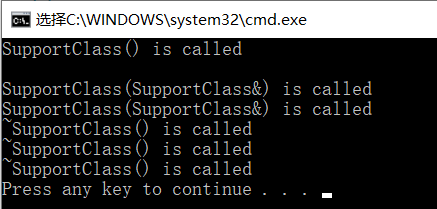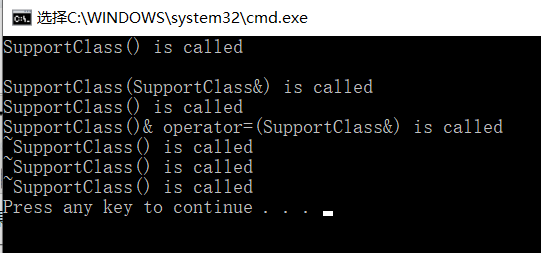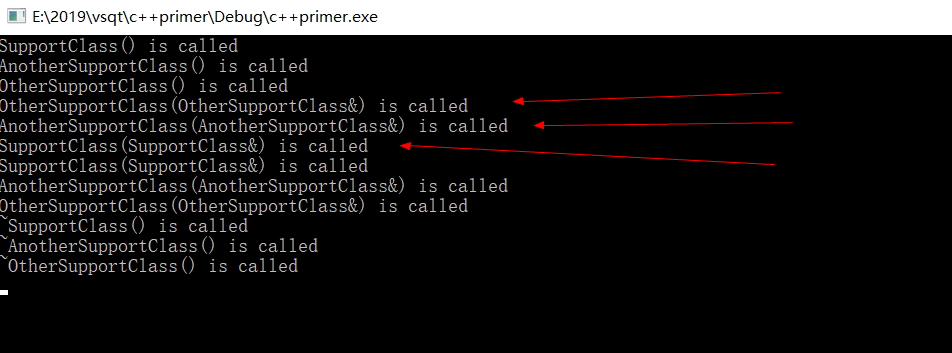case 1:在类外定义构造函数,所有data member都在初始化列表中进行初始化。
class SupportClass
{
public:
SupportClass()
{
cout << "SupportClass() is called" << endl;
}
SupportClass(SupportClass&)
{
cout << "SupportClass(SupportClass&) is called" << endl;
}
~SupportClass()
{
cout << "~SupportClass() is called" << endl;
}
SupportClass& operator=(SupportClass&)
{
cout << "SupportClass()& operator=(SupportClass&) is called" << endl;
return *this;
}
};
class TestInitialize
{
public:
TestInitialize(SupportClass arg);
private:
SupportClass data;
};
TestInitialize::TestInitialize(SupportClass arg) :data(arg){}
int main()
{
SupportClass sc;
cout << endl;
TestInitialize ti(sc);
return 0;
}
结果:

第一次默认构造:来自main函数中定义的变量sc;
第二次拷贝构造:来自形参拷贝实参;
第三次拷贝构造:来自data member 拷贝形参。
结论:与类内定义一样。
case 2:在类外定义构造函数,初始化列表为空,data member 在函数体中定义。
TestInitialize::TestInitialize(SupportClass arg) { data = arg; }
结果;

第一次默认构造:来自main函数中定义的变量sc;
第二次拷贝构造:来自形参拷贝实参;
第三次默认构造:来自data member 的默认初始化。
接着的 operator=:data 复制 形参。
结论:与类内定义一样。
case 3:类有多个 data 成员,全用初始化列表初始化,函数体为空
添加一个class:AnotherClass
class AnotherSupportClass
{
public:
AnotherSupportClass()
{
cout << "AnotherSupportClass() is called" << endl;
}
AnotherSupportClass(AnotherSupportClass&)
{
cout << "AnotherSupportClass(AnotherSupportClass&) is called" << endl;
}
~AnotherSupportClass()
{
cout << "~AnotherSupportClass() is called" << endl;
}
AnotherSupportClass& operator=(AnotherSupportClass&)
{
cout << "AnotherSupportClass()& operator=(AnotherSupportClass&) is called" << endl;
return *this;
}
};
TestInitialize::TestInitialize(SupportClass arg1, AnotherSupportClass arg2)
:data(arg1), anotherData(arg2){}
结果:

意外发现:
我的构造函数的参数列表是:先SupportClass,然后再AnotherSupportClass。
结果在由实参拷贝到形参时时:先AnotherSupportClass,再SupportClass。
又做了一个实验:再添加一个成员
class TestInitialize
{
public:
TestInitialize(SupportClass arg1, AnotherSupportClass arg2,OtherSupportClass arg3);
private:
SupportClass data;
AnotherSupportClass anotherData;
OtherSupportClass otherData;
};
TestInitialize::TestInitialize(SupportClass arg1, AnotherSupportClass arg2, OtherSupportClass arg3)
:data(arg1), anotherData(arg2),otherData(arg3){};

依旧是逆序拷贝构造的,重点是我不信邪,循环了100次,都是这个结果。
结论:函数参数列表的拷贝是随机的,并不是按照参数出现的先后顺序。
case 4:函数只能被定义一次,要么在函数内,要么在函数外。使用初始化列表初始化时必须定义函数!